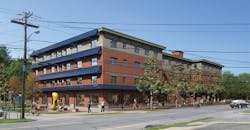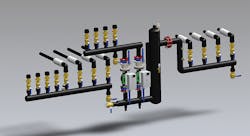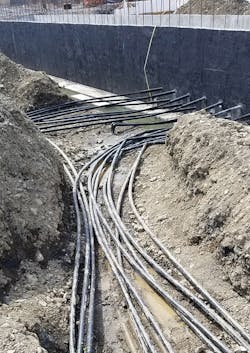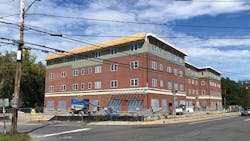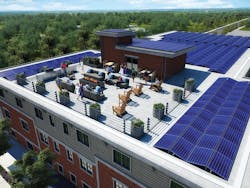NEW PALTZ, NY — Jens Ponikau learned his trade, geothermal system design, in his native Germany over 30 years ago. When he came to the US he (naturally enough) wanted geothermal heating and cooling for his own home, only to discover almost no one was working with the technology.
“I wondered why nobody was doing this,” Ponikau says, “for me it was a no-brainer. So I put in [my own] system, but I also realized the void in the marketplace. The states were going away from fossil fuels and towards renewables.”
Seeing the opportunity, he founded Buffalo Geothermal Heating in 2008, a company that specializes in geothermal system design and installation, while also helping maintain such systems throughout their entire life cycles. The company has more than a dozen employees, and the staff includes several IGSHPA (International Ground Source Heat Pump Association) certified installers and Certified (by the American Association of Energy Engineers) Geoexchange Designers. (Ponikau is also the current Vice President of the New York Geothermal Energy Association.)
“We also have about a dozen sub-contractors,” Ponikau adds. “For example, our excavators. We don’t do our own drilling, we sub that out.” Due to the nature of the work and the demands of the technology, Buffalo Geothermal works closely with developers at all stages of a project.
“We want to be the one-stop shop,” Ponikau says. “We believe it’s very important to know all the little ins and outs, all the little tricks and ways to design a system not only to work well, but to work very efficiently, so there’s nothing wasted in the process. There are so many little things you have to keep in mind, it really takes an expert in the field.”
Zero Place
Buffalo Geothermal’s involvement with Zero Place began when Ponikau was contacted by an energy consultant attached to the project.
Zero Place was founded by David Shepler, the COO of Elemental Cognition, an R&D company specializing in Artificial Intelligence. Shepler was formerly the Program Director of the Smarter Energy Research Institute at IBM (the same people who helped develop the Watson natural-language AI). Shepler partnered with Anthony Aebi of Greenhill Contracting—who has been building zero-energy homes since 2007— and builder/developer Keith Libolt of Affordable Housing Concepts. The construction manager for Affordable Housing was Mike Scirbona.
The idea behind Zero Place was to build a net-zero, mixed-use, multifamily building in New Paltz, New York, that could be a model for projects across the Northeast. Buffalo Geothermal had completed a similar building (on a slightly smaller scale) three years ago in Buffalo, NY, which immediately gave them an advantage over the competition.
“We were the only ones with a reference like that. We could say, hey, what’s the big deal? We’re doing this kind of stuff all the time,” Ponikau says.
Construction broke ground in 2018 and Zero Place is scheduled to open for its first tenants sometime in December of 2020 (the COVID-19 pandemic pushed back the opening by several months). The building will feature 46 residential units (25 two-bed, 21 one-bed), including five affordable housing units, and 8,400 sq. ft. of retail space.
“The trick is actually that all those multifamily buildings are what we call cooling dominated,” Ponikau says. “They put more heat into the loop field than they pull out during the wintertime. That means that, by definition, you need to make the loop field larger so it can carry the additional cooling load, just because the building is producing so much internal heat, because of its energy density. You know, it has 50 refrigerators, probably 100 TVs, it has probably 200 computers, just because of the density, when you get 100 people together in a building, that’s what happens.
“So even here, in Buffalo, or in this case the Hudson Valley, which is a very cold spot during the winter, you have a significant amount of excess heat produced by the building. And the entire trick about geothermal is that we use that heat, suck it out in the summertime and reject all that heat into the ground, and in the wintertime we recover that heat. So it’s more like a battery storage than us tapping for magma.”
System Essentials
Two essential elements of any geothermal application are the building envelope and the geothermal field.
For the envelope, Zero Place uses insulated-concrete form (ICF) walls, triple-paned fenestration, high-R slab and roof assemblies and thermal bridging reduction. The envelope performs 37 percent better than code and 65 percent tighter than NYS ECCC (the New York State Energy Conservation Construction Code). To maintain fresh air circulation without losing thermal efficiency, the building uses energy recovery ventilators (ERVs) for each individual unit.
Ground source heat pumps provide 100 percent of the building’s heating, cooling and DHW. The geothermal loop field consists of 15 wells drilled to 299 ft. depth. “After 500 feet you are regulated as a gas well, actually,” Ponikau explains, “so we tend to avoid it. You technically would need a mining permit, believe it or not.”
The entire geothermal field is within the building footprint, an important consideration when building in a densely populated urban area, given the high cost of real estate.
“Believe it or not, we only use 15 percent of the building footprint,” Ponikau says. “We could have put six or even seven times as tall a building on it and still get [the entire field] underneath the footprint.”
The wells use larger diameter pipe so the back pressure is not as high. A wider pipe also benefits heat transfer by providing greater surface area.
All-in-all, the application uses 60 geothermal heat pumps from WaterFurnace: 50 single-stage for apartments and hallways, two dual-stage for foyer and community bathroom, six variable speed geothermal pumps for commercial spaces, and two high temperature hot water generating heat pumps for 100 percent of the domestic water. There is, by the way, no gas line to the building which means zero emissions (not to mention some confusion from the building inspectors who had a difficult time believing you could actually build a multifamily building without one).
Zero Place will be only the second multi-family building to make 100 percent of domestic hot water via the geothermal system. In addition to the added redundancy, the system uses four 162-gallon storage tanks to accommodate peak hot water usage.
Wilo ECM pumps are used to circulate the water throughout the loop. Because of a balanced header system there are no balancing valves and no flow restriction. The system “picks up on and responds to any kind of change,” Ponikau says. “Fewer heat pumps running in fewer apartments and the circulation system slows down. It only circulates as much as you need in order to provide enough flow of water from the ground loop to each heat pump. If there are fewer heat pumps on it throttles back.”
As an added bonus, while each unit has its own dedicated heat pump, the pumps themselves are located outside the residences in the hallways. “The units were always very quiet to begin with,” Ponikau says, “but now there’s nothing inside the apartment that makes any kind of noise at all. The second thing is, for maintenance purposes, you don’t have to go into the apartments to change filters or whatever… maintenance crews have very easy access.”
Model for the Future
Key to the success of the Zero Place project has been an ongoing partnership with NYSERDA, the New York State Energy Research and Development Authority. The public benefit corporation managed to provide $109,000 in efficiency rebates, did a secondary design review and will be performing independent energy monitoring and energy verification once the building is occupied.
NYSERDA sees Zero Place as an important test case. They’re hoping lessons learned from the project can influence and educate future policy makers about the kind of return on investment geothermal systems can deliver in the Northeast, where extended, chilly winters are the norm.
To help improve the quality of data obtained from the project, WaterFurnace delivered in-kind support by installing 15 remote control and monitoring systems attached to its heat pumps, each streaming 256 data points every ten seconds.
“NYSERDA has to go back and verify the accuracy, so everybody worked hand-in hand and went the extra mile,” Ponikau says. “You know there’s no data on this that anyone can go by. Now the fact that this is all renewable, completely emission-free is intriguing for them. This project will be the first of its kind on this scale, and because of this they’re urgently awaiting the results.”
Data on the project is important because the design is really pushing the envelope of what is possible in an energy efficient building without sacrificing comfort. “We would actually argue that we are increasing comfort,” Ponikau says. “The owner didn’t shy away from spending money to invest in the extra efficiency and extra comfort… a lot of developers only think about the initial investment because they’re going to flip the building anyway in five years, so they don’t care how efficient it is. It’s a little bit different here.”
That difference extends to the tenants themselves who have been selected to participate in the ethic of the building. Each tenant has full control over their own heating and cooling. Zero Place bundles power and water with rent. There are lease agreement limits with payments for exceeding consumption thresholds. Custom mobile software informs tenants of their energy usage, including a posted “leader board” of the most energy efficient occupants.
Final Numbers
The final price tag for the building was $10,547,313, which works out to a cost per sq. ft. of $167.57. But the much more interesting numbers are in the projected energy savings: between a 20 and 25 percent premium over an NY ECC-code compliant building, savings that work out to an estimated 8-10 year payback (including the cost of insulation, geothermal, and the rooftop solar system).
The numbers are so good that NYSERDA has already named Zero Place as one of its Round One, Late Design Phase winners of the Multifamily Building of Excellence Award. The Award is part of a state-wide competition to stimulate the design, construction, and operation of very low, or zero carbon emitting buildings. Along with bragging rights, it includes a cash award of $750,000.
[To learn more about the program, visit https://www.nyserda.ny.gov/All-Programs/Programs/Multifamily-Buildings-of-Excellence/About ]
Ponikau hopes that the building lives up to and exceeds its promise once it is fully-occupied, and that Zero Place can serve as a model for the entire net-zero building community.
“It’s great to be on the cutting edge of something like this,” Ponikau says. “Multifamily, mixed-use buildings like this, they’re just a staple in big cities the whole world over these days. And if you can prove that something like this can be net zero and worthwhile within the environment! I mean, we’re talking 50 miles south of Albany, NY, with -15 degree winters and 95 degree summer days.”
It could mean big changes for how people live and use energy in some of the most populous states of the country.
About the Author
Steve Spaulding
Editor-in-Chief - CONTRACTOR
Steve Spaulding is Editor-in-Chief for CONTRACTOR Magazine. He has been with the magazine since 1996, and has contributed to Radiant Living, NATE Magazine, and other Endeavor Media properties.
